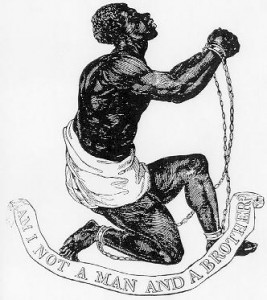By Stephanie Kugler
“The Constitution is interesting – the slavery part I mean – how they never mentioned the word slavery and the inequality with the 3/5 compromise.” This is what makes the Constitution worth studying, according to some 14-year-old students in California. I teach these eighth graders in addition to about 90 others and if there’s one thing that I’ve learned over the years, it is that even though teens are rarely intrigued by dry constitutional history or basic civics lessons, they are equally appalled and fascinated by how the Framers handled the various slavery controversies in 1787. Because of this intrinsic interest, recent events in the news, and my own desire to have my students engage in thoughtful academic arguments, I created a lesson in which students would answer an investigative question: Was the Constitution Pro or Anti-Slavery as it was written in 1787? For academic historians, this is a familiar discussion that just heated up all over again now that political figures like Bernie Sanders and scholars like Sean Wilentz have weighed in with provocative opinions. As soon as I encountered some of these recent debates on HNN and elsewhere, I knew I had to try to teach it because my students would be full of their own engaged and unique perspectives. While far from perfect, this lesson provided my students the structure and support to revisit a primary source of history, the Constitution, as well as analyze excerpts from two very recent secondary sources –literally dueling op-eds from September 2015– which present conflicting arguments regarding the Framers and their original intentions over the future of slavery.
As part of their assessment of this lesson, students wrote paragraphs outlining their arguments to answer the historical investigative question. Unsurprisingly, the majority of my students came to the conclusion that the Constitution should be viewed as pro-slavery. Their sense of right and wrong at age fourteen is very clear and the existence of slavery alone makes the Framers guilty in most of their minds. One student in particular argued it was pro-slavery because he believes the delegates made sure that no living slaveholder would ever suffer real consequences from abolition. What he meant by that claim was that compromises, such as putting off the possibility of abolishing the slave trade until 1808, simply guaranteed any still-living former delegate would probably “be too old to benefit from slavery.” While the “too old” may be an exaggeration, the evidence is valid in that it shows he understood that those who were making the rules had a stake in the decision and that many of the slave-owning Framers still had many years to benefit from the system they supported.
When assessing my students’ work I am hoping they will be able to present a claim supported by historically significant and reliable evidence, following the model of academic historians. Some were successful, others were not. But that is OK, because the lesson was in October and they are still learning. Those who were less successful simply restated claims from the historians they read and did not explain the significance in their own words or connect their thinking back to historical evidence. Those who were more successful analyzed evidence and connected back to the primary source. For example, one student who argued in support of the Constitution as an anti-slavery document, suggested “the Constitution is anti-slavery because the delegates never said the word slavery. They never used the word slavery because they never wanted to give in to the idea that humans could be viewed as property.” She was one of the only students to put forth this argument in her writing. Other students saw this evidence as weak, but she agreed with Wilentz’s assertions that the principle of “property in men” was not tolerated by the Framers. The strength of this analysis came from her ability to effectively cite Wilentz’s argument, explain his thinking, and then connect it back to the Constitution.
The other major challenge with asking students to compose historical arguments related to such high-interest topics is that they often cannot separate their initial impressions or pre-conceived notions from the academic argument. Many of my students read the title of Wilentz’s article and scoffed, “he is wrong, slavery existed past the signing of the Constitution, therefore, the Constitution must be seen as pro-slavery.” This is why the public debate was helpful and why it’s necessary to have students go back to the primary sources before and after reading secondary sources. One student argued the Constitution was pro-slavery because “slavery was not abolished, only the slave trade. Slaveholders could still get more slaves from the slave women and this is the real reason the Constitution was both racist and pro-slavery.” While it is clear this student had passion for his claim (hence the bold), his analysis was still grounded in evidence from a primary source – remaining an evidence-based argument.
How did my students come to such authoritative (if debatable) judgments? Here is where I think the value of online platforms for academic history really can become transformative. In this instance, they enabled a middle school teacher in California to engage and present a complicated and practically real-time historiographical debate in terms that provoked some serious historical thinking from an eighth grade social studies class. Without this heated online discussion among academics, I never could have provided such an experience for my students.
Stephanie Kugler teaches at Bridgeway Island Elementary School (K-8) in West Sacramento, California. She has received permission from the students and their parents to share their work on this assignment with a wider online educational community. Stephanie can be reached by email at stephanie.kugler@gmail.com

